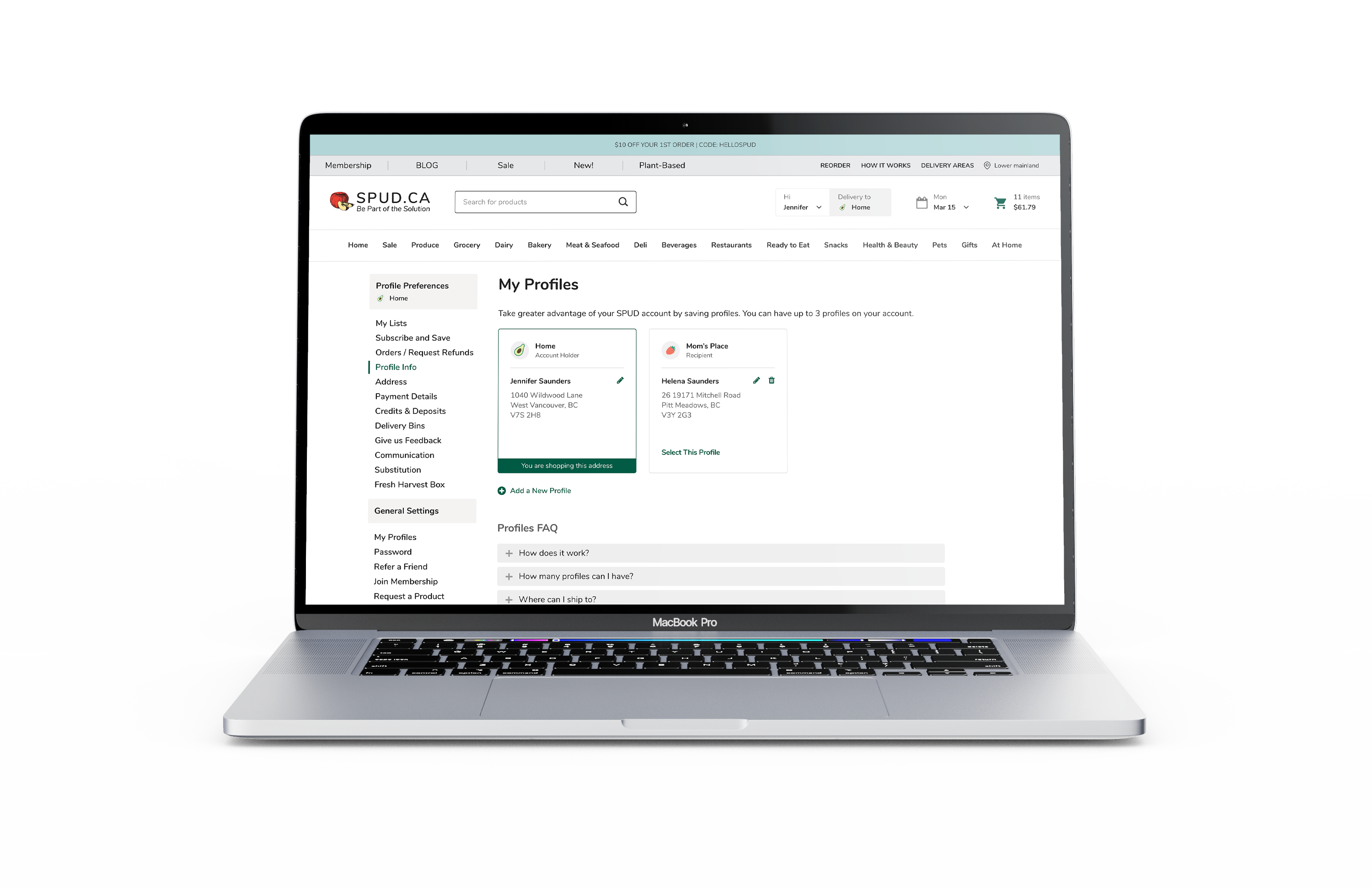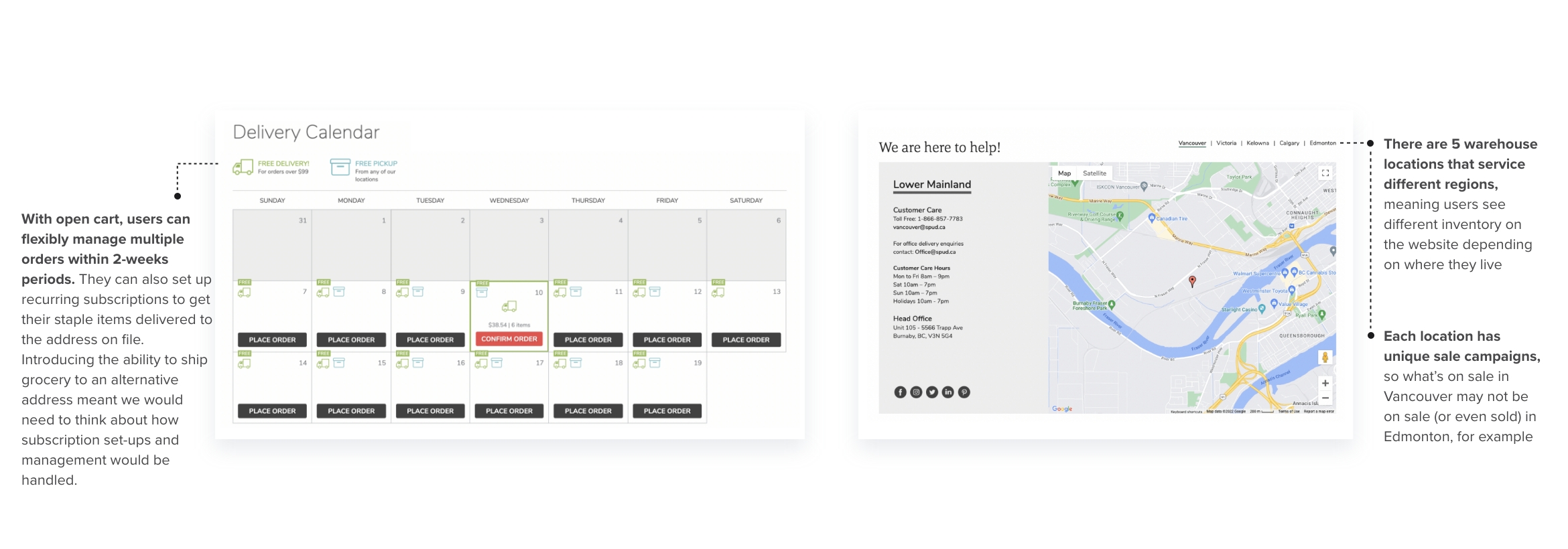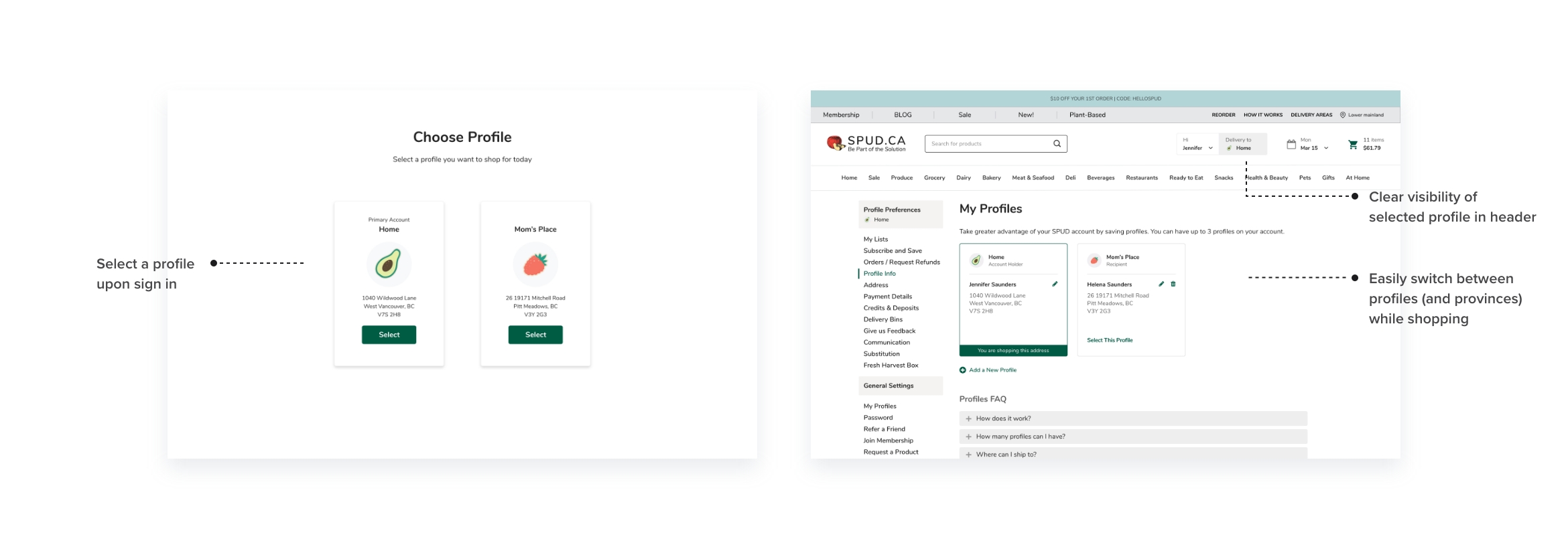Project overview
Just as Spud customers want to get their grocery delivered when it works for them, we want them to experience the same flexibility and control for where they get their grocery delivered. Spud profile allows people to get their groceries delivered to anywhere that’s serviced by Spud’s warehouses (lower mainland, Vancouver Island, Calgary, Edmonton, Kelowna), so they can send groceries to their loved ones during the pandemic and beyond, or even get groceries delivered to their airbnbs during vacations.
I worked with 2 other designers with a team of product manager and 3 developers. My design teammates and I worked together on ideating early concepts, presenting to leadership, and delivering final assets for production, and led the QA during development.
Problem
Like most retailers, summer is typically slow for Spud as customers wind down on their regular grocery orders and go on vacation. To increase revenue, Spud wanted users to be able to add additional addresses to their account so they may choose to receive their groceries anywhere that’s serviced by Spud’s warehouses, or even send groceries to their loved ones during the pandemic.
Adding an additional address may seem simple enough for an e-commerce site, but it required a ground-up thinking of the way addresses are tied with other Spud features, such as the open cart, subscriptions, and membership discount benefits, as well as technical constraints.
Goals
- User: send groceries wherever they want
- Business: increase engagement and revenue during the summer
- Product: increase product flexibility and remain competitive
Adding a secondary address is pretty common for online shopping, but on Spud there are logistical complications. The first challenge was addressing all potential touch points and edge cases that can occur during user journeys. To minimize potential disruptions and ensure the users were aware of the changing inventory (ie. site offerings such as products, sales, and deals are different for each warehouse region), we needed to implement clear feedback to help users understand what was happening at each step, and guide them to undo or resolve any errors.
Research
Determined to make the new feature work the way our customers expect, we conducted a competitive analysis to understand users’ existing mental models. Our investigation of four direct and indirect competitors verified that adding an additional shopping address is usually a simple step that’s presented at the end of a checkout process, during which users can add a new address or choose from a list of pre-saved addresses.
To ensure that this feature integrated seamlessly with Spud’s existing ecosystem, we mapped out all relevant journeys to identify important touch points and edge cases where we would need to clearly communicate to users that they were adding a new address, shopping for a new address (including setting up new subscriptions for the chosen address), or managing saved addresses.
But facilitating a smooth shopping experience on Spud is more complex than it seems. On Spud, each user has an ‘open cart’, which allows them to submit as many orders as they want during two-weeks rolling periods (orders can be edited and cancelled anytime until the evening before delivery). They can also set up subscriptions, reserve seasonal items in advance, and shop special promotions that are specific to each warehouse region. The inventory is vastly different across these regions, and for each warehouse, items usually vary in availability depending on which day you’re shopping for (because Spud tries to avoid over-stocking to limit food waste), which also added to the complexity.
During this time, the development team found that Spud’s existing technology would make it impossible for a single customer account to have addresses from multiple provinces. This required a fundamental shift in how we view addresses - how the data could be organized into customer accounts, and presented in a way that’s familiar to users, which gave me inspiration for how to approach this problem.
Complex challenges like these were among several identified during the research and ideation stage, and validating the initial solution and working closely with the developers were key to our short one and half-month turnaround.
How it works
 Personalized grocery shopping
Personalized grocery shopping
We re-examined the act of ‘adding an additional address’ by reframing it as profiles that are created under an account. This approach was technically feasible as it was simply creating new accounts but organizing them into an existing account in the backend at no added cost. Each account can have up to 3 profiles with its own set of dietary and substitution preferences, favourites, subscriptions, and eventually its own product recommendations based on the users’ shopping history. This made it easy for users to curate personalized experiences for themselves and their loved ones (especially during the pandemic).
 Inventory management made easy
Inventory management made easy
Users simply need to choose the profile they want to shop for without having to deal with persistent communication around changes to their cart or the site inventory when switching between lower mainland, Calgary, Edmonton, Vancouver Island, or Kelowna.
 Shared benefits
Shared benefits
With profiles, users with extra benefits (eg. Loyalty points, membership discounts) can pass on their savings to their profiles so that the profile accounts get the same great benefits. This was a business decision to encourage feature adoption and drive revenue.
Results
Profiles launched in July 2021 and within a month it generated additional $34,000 in revenue, which surpassed $260,000 by February 2022. Since its launch we’ve seen a steady increase in the number of profiles being created, and orders placed with profiles. Of this, more than 300 users are membership users who are sharing their savings via profiles.
Now, profiles are considered to be a distinguishing feature for Spud among its local competitors, and its success has recently prompted the leadership team to expand the feature by increasing the maximum number of profiles per user from three to five.
(or just drop me a line to say hello 
All Rights Reserved © Kristine Hur 2022





